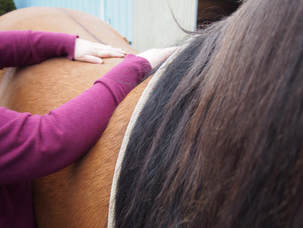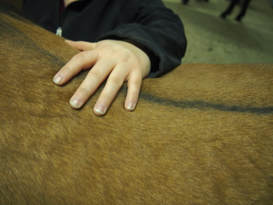 Have you ever been working with your riding instructor or farrier, and they said something like, "Your horse is moving better!" And you just smiled and nodded, because you aren't sure what they are seeing? Or maybe you were that instructor, and you could see that the horse was moving more comfortably, but couldn't quite explain how or why. And when you tried to explain it, the owner kind of squinted and said, "Um, maybe I can see what you mean??" What if you didn't have to just trust that the horse is making improvements - What if you were empowered to see what your care team mean when they say your horse is looking 'better', or to know when your horse's body is feeling less than their best? In this 1-hr, online course, you will get to learn more about your horse's posture - what it is, why it's important, and what it can tell you about the health of your horse's body and movement. Armed with this new awareness, you will be better prepared to fend off lameness, ride your horse into health, and have vocabulary to talk to your care team professionals. Professionals and non-professionals alike will benefit from this class. It has been previously taught to folks from beginners to seasoned clinicians, and all were able to learn something new to take with them on their journey with the horses! To find more info, and to register, please follow the link below:
0 Comments
 I have found that massage can be a wonderful meditation. It allows a connection with equines that I haven't found with other techniques or methods of work. It can also soothe and calm the nerves of the people performing the massage. Passive touch is a wonderful technique that can be used to build the bond between you and your equine and soothe your own stress when the world around you is angry and experiencing unease. Stand near your horse. Breathe slowly in. Then breathe slowly out. If it helps, close your eyes, and allow your other senses to take over. Notice the smell of fresh hay, leather, and horse hide. Listen to the twitch of a tail, the soft inhale of breath as your equine stands next to you. Focus on how the air feels on your skin. Slow your breath. Feel how the small of your back softly expands with each inhale. Breathe in. . .2, 3, 4. Breathe out. . .2, 3, 4. Now take another breath. In through your nose, 2, 3, 4. Out softly through your mouth, 2, 3, 4. Those who spew hate and fear depend on those of us who preach love and tolerance becoming overwhelmed and losing our perseverance. These quiet moments spent with your horse, these moments of calm and stillness, will recharge you for the fight to come. Remember that self-care is an act of radical resistance. Allow your shoulders to relax. Breathe in, 2, 3, 4. Allow your feet to sink into the ground. Breath out, 2, 3, 4. Step up to your horse, so that you are facing their side. In a smooth, deliberate motion, place one hand on their withers, and the other at the top of the croup with a light pressure. Or, place one hand on their chest, and another at the withers. Feel the texture of the hair, the skin, muscle, and bone under your fingertips. Breath softly in, 2, 3, 4, and back out, 2, 3, 4. As your breath slows, and you allow peace to enter, notice how your horse's breathing may change to match yours. They may release a soft sigh, or lick their lips, or yawn. Allow your horse to process. Allow yourself to process. Breathe in, 2, 3, 4. Breathe out, 2, 3, 4. Feel the warmth of your horse's body, and allow that warmth to enter yours. Horses by their nature are 'in the moment.' Allow this moment to stretch and last. Let the peace wrap around you and your horse. You may notice a change in the temperature of your horse's skin under your hands, or the muscles may become less resistant to the light pressure. Allow yourself to acknowledge these changes. Your feet may sink deeper into the ground, your back may softly round, your chest may open up. Allow your body to accept these changes in posture. Breathe in, 2, 3, 4. Breathe out, 2, 3, 4. Focus on the contact where your hands are placed on your horse, and feel the connection build between you. When you are ready, you may want to slowly stroke your horse with a soft, light pressure, and thank them for sharing their calm with you. Breathe in, 2, 3, 4. Breath out, 2, 3, 4. Take this peace with you, allow it to bolster your determination, and share it with others. After hearing about the benefits of equine massage, you have decided to set up an appointment for your equine partner. That is wonderful! If this is your equine's first-ever massage, you may not know what to expect; to help, I've written down a few guidelines for how things tend to go on my new client visits.
For the first few appointments, I will request that the owner meet me at the barn prior to working with their horse. Not only does this give me a chance to chat with you about how your equine is doing, I also like to have the guardian fill out a brief summary on the SOAP chart prior to beginning the session. The SOAP chart provides a record of the appointment. The top half provides me with the basics: your name and the name of your equine, date of service, vet information, and your equine's breed, age, and health history. Information that is helpful in the health history would include any issues you may have noticed recently and any past lameness or health problems (regardless of whether or not the issue(s) were diagnosed by a vet). For instance, you might put that your horse's gait has been unusually short-strided, or felt "off" recently. The second half of the chart is a record of the things I notice while performing body work, the actions I perform during our session, and any future recommendations and/or "homework" I may suggest for you and your equine. At the end of the session, you will receive a copy of the SOAP chart for your records. It is appreciated if your equine is haltered and ready for their appointment when I arrive, and not out in the 'back forty.' While I do enjoy hiking, I would prefer to spend our session performing bodywork instead of working on my cardio. However, it is usually better if your horse is not groomed before I get there, as there may be signs or signals that may inform my work that are literally brushed away during a grooming session. That said, if your horse is very muddy, it is not a bad idea to knock off some of the excess dirt. In addition, if it's fly season, you may want to apply a bit of fly spray before I arrive. I want your horse to be able to focus on the massage and their body, not on obnoxious flies. A clean, dry, and level place to work is also appreciated. A level place will allow a more accurate assessment of posture, stance, and any lameness or conformational faults far better than an unlevel surface would. And anyone who spends winter in Western Oregon can understand why a dry place to work is necessary! It is also preferable to have the session somewhere quiet. If your equine is at a busy boarding facility, this may just mean working in your horse's stall. I prefer not to work in the middle of a busy barn aisle for a number of reasons; the first of which is your horse and I will both be distracted if there is a lot of activity going on -- it is for this reason that I also prefer to avoid performing bodywork during mealtime, as your equine will have their attention on dinner arriving, rather than on their body. In addition, I hate to be rude, and I do not want to be in someone's way while they are trying to clean stalls or feed and water their own equine. Depending on your equine's demeanor prior to starting a session, I may or may not ask you to hold your horse. For the first session, my equine clients are typically kept haltered, with a loose lead draped over my arm for safety. However, there are times I may want to remove the halter (such as to see them move out in an arena), or I may want to tie them if they are especially distracted or agitated. I do not prefer to cross-tie during a session, as it restricts their movement, and may hide something I would notice more readily if the horse is free to move. If you are holding your horse during our session, I do request that you pay close attention to their behavior, and try to block them if they attempt to nip or bite at me; often, the work I perform is necessarily in 'squeamish' areas, because those are typically spots where your horse is feeling discomfort. Strong correction is not necessarily needed here, just a quick bump on the lead rope or halter to keep their head straight. If you have any questions during or after a session, please feel free to ask them! I love engaged owners, and I am happy to explain what I am doing and why I am doing it. I am also happy to show you some stretches or massage strokes that you can do between sessions to keep your equine healthy and happy. Additionally, I encourage collaboration between professionals; if your vet or farrier has any questions for me (or if I have questions for them), I would love to chat with them, as well. |
Author NotesThis blog will serve as a source of information for equine owners and enthusiasts. Archives
April 2025
Categories
All
|


 RSS Feed
RSS Feed